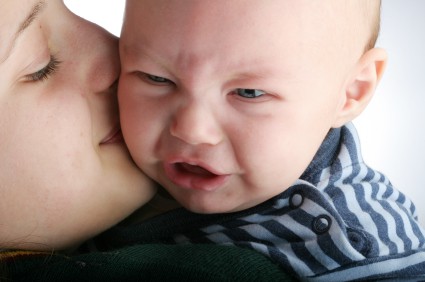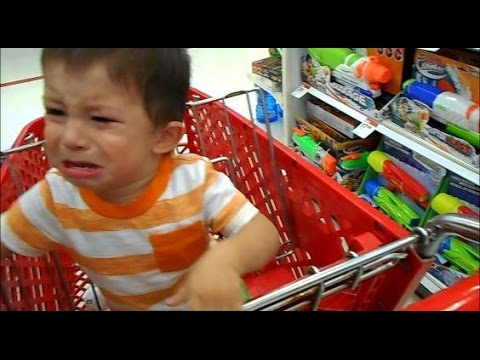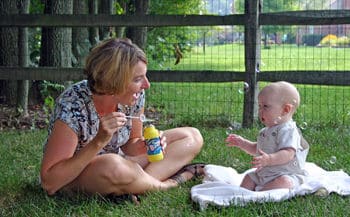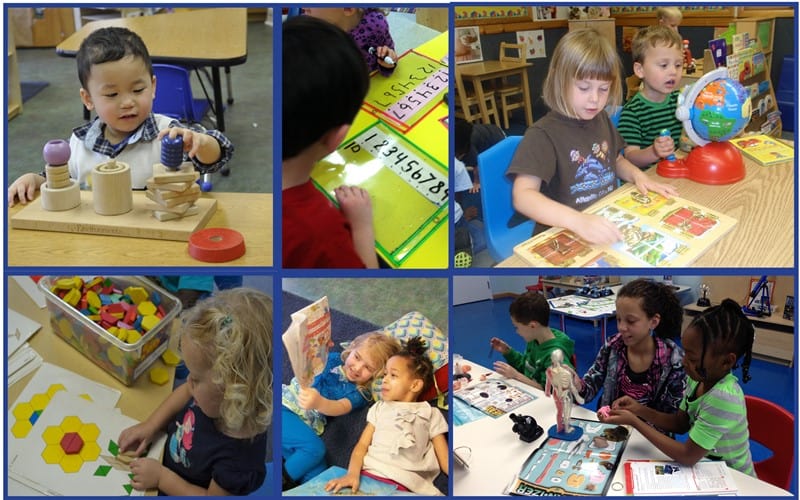Public Tantrums? Here’s How to Handle Them
Another tantrum in the store?
Ah…the beloved moment when your child begins to act as a human windshield wiper against the grocery store floor. It’s a humbling experience for all to go through a public temper tantrum. We’ve gathered some tips and thoughts on how to turn the embarrassment level from a 10 to a 5. Let us know what you think.
- Before going anywhere, try to stock your bag with snacks and drinks. Sometimes all it takes for a meltdown is a want for food. Sure, your food may not be the object of desire as you stroll by the chocolate chunk cereal….but it may appease the anger for a little longer.
2. Be an example of how to act: You want to pull your hair out. We get it. Completely. But your toddler doesn’t need to know this. This fact may only make your little one more upset. Stay calm and take deep breaths. Rushing out of the store won’t make your child any more calm. In fact, it may cause more agitation. Once out of the center of attention, keep your wits. Don’t attempt ending the ordeal quickly. Rushing the process is a recipe for disaster. Sit down with your little one and let them know you understand how they’re feeling. Pat them on the back or sit them in your lap. Let the little one know it’s okay to have bad feelings but that it’s time to calm down.
- “What can I do for you?”: Asking a question like this lets your little one know you are on their side. It does not mean you will give them what they want, but opens up a dialogue to explain the situation. Maybe they can’t have that lollipop because it has too much sugar…but they can have an oatmeal bar! No matter what – don’t give in to the reason of the temper tantrum no matter what. It will only make your child realize that all they have to do is throw a fit to get anything they want. Stick to your ground and keep calm. You’ll get through it…we promise!
Minnieland Academy provides early childhood education and care for infants through school-age children.
Founded in 1972 by Chuck and Jackie Leopold, Minnieland Academy has provided Virginia families with the best early childhood education and care for over 40 years. We have over 60 schools that serve infants through school age children, helping them develop in a loving environment. We believe that learning is fun, and our Kid Steps curriculum provides age appropriate education at every level of their growth.
Come tour one of our schools and become part of the Minnieland Academy Family! https://www.minnieland.com
Productive Parenting
We get it. Parenting is tough. Parenting is not for the faint of heart. Parenting makes you sometimes want to pull your hair out…unless your child has beaten you to the punch on that one. We’ve scoured the web for some tips that may help get you through the day…. productively. Let us know what you think, or if you have some tips to add to the list!
- Wake up…earlier!
Everyone knows a morning routine with kids is in no way simple. There are kids to be dressed, teeth to be brushed, breakfast to be made, and sanity to be maintained. Sometimes the key to being productive simply means having time to focus on you before the craziness begins. This might mean a cup of coffee or some reading out of a good book. The choice is yours, but it starts with waking up early to get a head start on the day!
- Keep that routine
Structure helps to keep children in order, and a regular routine helps that structure. Kids like to know what to expect and when to expect it. The same can be said for adults, especially adults with small children. Write down the routine in a place where everyone can see it. This way everyone knows what, when, and where they are supposed to be at a given moment!
- Presenting a hobby
Sometimes all it takes for you to get your work done is for your child to be kept busy…and to enjoy that source of busyness. Moms can relate in that if your child is restless, sooner or later you will be entertaining that restlessness! An easy way to avoid this is to find something your child enjoys doing and put that to use! Just like you may have had a go-to-hobby when bored (once upon a time?), give your child that same source of joy. Does your child enjoy instruments? Give them an instrument to play with every day. Interested in painting? Give them a variety of things to paint. Think creatively and out of the box as well!
- Bored? Boredom doesn’t exist
What if nothing else is working and you are trying to finish the laundry and the little one walks in whining those dreaded words — the familiar, extended tone of, ‘I’m borreeed.’ These two words carry a lot of meaning. For most parents, it means that your child wants your immediate attention and that whatever you might have been planning for the next hour has just gone out the window. One saying has the potential to break the cycle: “There is no such thing as boredom.” Parents have attested that while these words may seem arbitrary, telling your child this and then going on to instruct them to be productive or use their imagination has actually helped the ‘case of boredom.’ It puts the problem of not having anything ‘fun’ to do directly with the child. Try it out and see for yourself! You might end up being more productive yourself as a result.
- The choice is theirs
What if your child is not bored, has finished their activity of the day, and it’s a Saturday off from the usual schedule? You’re cleaning up from lunch and your attention (and only your attention) is required…so much so that it’s hard to finish cleaning the kitchen. Give them a choice: “You can stay and help me do chores, or you can leave and play.” More often than not, you either earn yourself a little helper or you get the job done ten times faster (as your child skips away from responsibility).
———————————————————–
Minnieland Academy provides early childhood education and care for infants through school-age children. We believe in learning in a loving environment.
Founded in 1972 by Chuck and Jackie Leopold, Minnieland Academy has provided Virginia families with the best early childhood education and care for over 40 years. We have over 60 schools that serve infants through school age children, helping them develop in a loving environment. We believe that learning is fun, and our Kid Steps curriculum provides age appropriate education at every level of their growth.
Come visit one of our schools and become part of the Minnieland Academy Family! https://www.minnieland.com
What Determines a High Quality Child Care Provider?
Mistakes to Avoid When it Comes to Disciplining Your Child
However, as much as we know guidance and discipline are important to our children, there are instances when we may actually be doing it improperly. Here are some examples below to be aware of:
- Yelling at them – Yelling happens, but of course it is not ideal as it can cause our children to fear us. Yelling can convey to our children that we are not listening to their frustrations and encourage shouting as a way to enforce will versus talking through things. As a result, kids can actually become
more rebellious. Talking through why you are upset, or why a behavior is bad helps to teach cause-and-effect and reasoning skills. - Nagging – Do you want to repeat yourself over and over again? Do you love hearing someone repeat themselves over and over again? Neither do your children. Nagging will only frustrate you and encourage your children to tune you out. Creating a system of warnings and results if your requests are not met is another great way of teaching cause-and-effect to your children. For example, “If Mommy has to ask you to do something 3 times, X will happen because you did not listen.”
- Giving in instantly – What’s the use of setting rules only to bend them? Kids learn pretty quickly how we work, and can get very good at outsmarting us! If you always give in to them whenever they whine or cry. There is really no point of putting effort into discipline. Your children will only find a way to break the rules. Hold fast, even when the crocodile tears start to well up.
- Expecting a lot from your children – Kids will be kids and since they only know and experience a little, they will stumble along the way. Expecting too much from them will only discourage them and can make them overly cautious and guarded for fear of disappointing you. Be realistic and understand the limitations of your children. Work with them to encourage them – and of course, reward positive behavior when it occurs, and tell them why.
- Becoming inconsistent – Are you allowing them to slide once in a while? It may seem “kind” for parents to let the kids slide from time to time, but doing so will only make them realize that it is okay to make mistakes or not follow the rules if they feel they can get a mulligan.
- Being negative – Excessive negativity can have a powerful impact on the development of your child. Be mindful of the words you use. Instead of focusing on negative reinforcement for bad behavior, use positive reinforcement for good behavior. Kids love praise from their parents – just be sure to explain the ‘why’ as children are inquisitive by nature while they work on figuring out how the world around them works.
Basic Outdoor Safety Tips to Keep Your Child Safe
The outdoors are great for your children. It gives them fresh air, sunshine, and overall better health. They can play with their friends and run around, which keeps their bodies active. They can explore your yard and gardens and use their imaginations to create fun scenarios in their heads.
There are so many things that the outdoors can offer, but safety is not always guaranteed. In order to let your kids play outside without worrying about them, here are some basic safety tips you should keep in mind:
- Do not let them play outside without adult supervision. Even if you don’t join them in playing, keeping a watchful eye can save them when danger arises.
- Teach your child never to go beyond the fence. It is important that your child understands that rule and follow it strictly.
- Always lock the gates. There is no need for your child to open the gates and get out of your yard.
- Remove any hazardous, sharp, or electrical materials from their play area. These are potential sources of dangers.
- Apply sunscreen during summer and proper warm clothing in winter. Always dress your child appropriate based on the season, so they do not become overheated or develop a cold from being too chilled.
- Equip your child with a safety helmet and kneepads when riding bicycles, skateboards, or other moving toys.
- Keep outdoor tools and equipment in sheds or away from your children. Bring your gardening tools and barbecue grills inside if possible.
- Inspect their play area. Is all play equipment working fine? Is there any damage on the seesaw, monkey bars, or swing? Check it out to see if there are possible sources of accidents.
- Allow your child to play only on equipment appropriate for their age. Certain equipment like monkey bars is not safe for toddlers for example..
- Watch them closely when they’re swimming in the pool. Never leave them unattended.
- Remove or section off plants that could be potentially hazardous to their health. Educate them on what they should and should not touch.
How To Choose Age-Appropriate and Safe Toys
 Few things give your child more joy than a new toy (except for maybe the box that it came in…). Toys help to create a vast colorful world of endless wonder and make-believe you and I can no longer really “see”.
Few things give your child more joy than a new toy (except for maybe the box that it came in…). Toys help to create a vast colorful world of endless wonder and make-believe you and I can no longer really “see”.
Unfortunately, toys today may also pose a threat if not selected properly. There are toys that unsafe and not appropriate for the age of our children. It is important for us to scrutinize toys we want to give our children first, before handing them over.
Here are some tips on how you can choose age-appropriate and safe toys for your children:
- Check the package- Toys come with an age recommendation and some with safety instructions, be sure to read these instructions first to prevent injury. There are toys that are only ideal to 6 years old and above since these contain small parts that little ones can swallow.
- Evaluate its durability- Is it strong enough not to easily break? It is a risky to have toys that can easily shatter into pieces and cause its small parts to scatter around or scratch your child.
- Look for safe ingredients- You can find what makes up a toy in its own packaging. Check the ingredients and see if there are hazardous elements!
- See if it is educational and developmentally appropriate- We want our kids to not just have fun, but also learn from their toys. Today there are ample toys available that are developmentally appropriate for your child’s age.
- Choose simple toys- The simpler they are, the wider the imagination of your kids when playing. Toys that are too specific offer less room for the imagination as everything is already set out for them.
- Give one toy at a time- Give your kids time to enjoy the a few toys first, so they will really maximize the enjoyment of those toys. While an argument can be made that one can never have too many toys – too many at once for a child can be less than ideal.
- Understand the learning needs of your child based on his age- For instance, children who are 2-4 years want to stimulate their imaginations, while babies from 6-8 months do well with repeatable activities.
- Be careful with electronic toys- Toys that are powered through batteries and electricity are risky to children especially toddlers and babies. They can try to plug and unplug or even taste the batteries.
Helping Your Child in Decision Making
 Candy, TV Shows, Toys and even what to wear, there are a lot of things a child CAN make choices on. Oftentimes, we do the choosing for our children and sometimes we just give in to what they want the first time… not always the best option.
Candy, TV Shows, Toys and even what to wear, there are a lot of things a child CAN make choices on. Oftentimes, we do the choosing for our children and sometimes we just give in to what they want the first time… not always the best option.
Kids will not be able to do well in decision making unless we help them to begin thinking for themselves with small decisions from an early age.
Children who are well-verse in aspects of decision-making early on, grow up to become smart and responsible adults with an increased sense of cause and effect. Since they know how to properly choose for themselves and stick to their decision, they are able to think more critically in all of life’s decisions.
Though kids will only have to decide on things such as; toys, games and food, it all starts small. Below are some ways on how you can help them in decision making:
- Reduce their options for them. You may not decide for them but you can make it easier at the start. Help them decide better by limiting their options to where they can comfortably choose. Sometimes, too many options will only confuse them, adding a sense of pressure.
- Let them make decision even if you think they will choose incorrectly. What your kids need to learn is to know that they can make mistakes sometimes. There is no perfect circumstance thus they do not need to be perfect all the time. The mistakes they do sometimes make can help them become stronger and more self-reliant as they mature.
- Be an example for them. Kids will always try to follow what adults do. Live the kind of life that you want your kids to have. If you want them to be wise in making decisions, set an example for them.
- Help them get a clear picture. Children do not have enough experience to identify which is a good decision or situation and which is not. Help them decide better by creating a clear picture for them of what will happen if they choose this and that. This will help to further teach your children the concept of cause and effect.
- Support their decision. Show kindness and support to your children and they will feel more confident. If they choose a decision, support their decision, even if it isn’t exactly what you would have chosen for them. Let them know that you are there always no matter what.
- Let them know that you trust them. Give your kids the assurance that you trust them in making a good decision. This will encourage them to not only feel confident in their decisions, but also to make the right decisions.
Sharing Parenting Duties Successfully

Sometimes you have to share parenting your child with others such as spouses, grandmothers, and child care teachers.
The key to success is communication and trust. Listen with respect to the child rearing styles of your child’s other caregiver and talk openly about yours. Come up with a plan that accommodates both styles, try it out, and meet again.
Sometimes you may have to adapt your plan a few times before all are comfortable. The important thing is for your child to learn to build trusting and positive relationships with others.
-Dr. Rosemary Burton
Vice President of Education,
Minnieland Academy – Virginia Childcare










